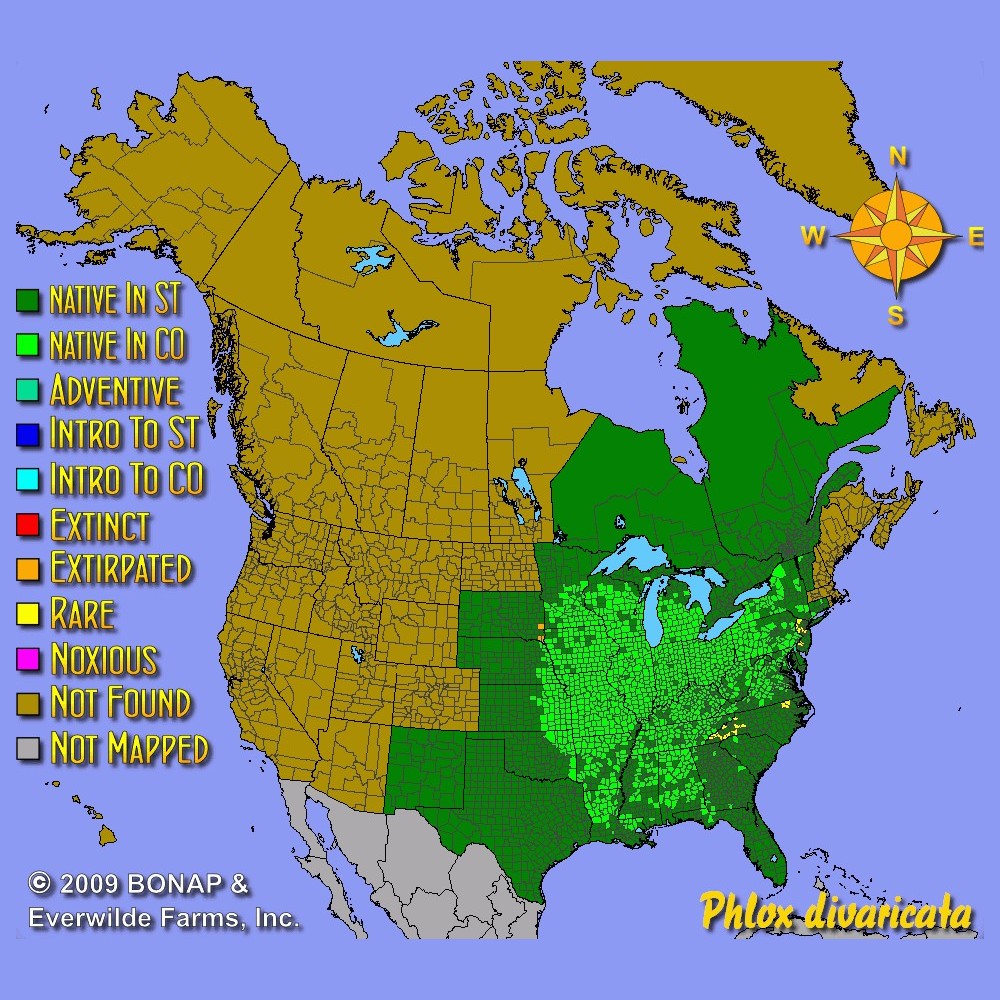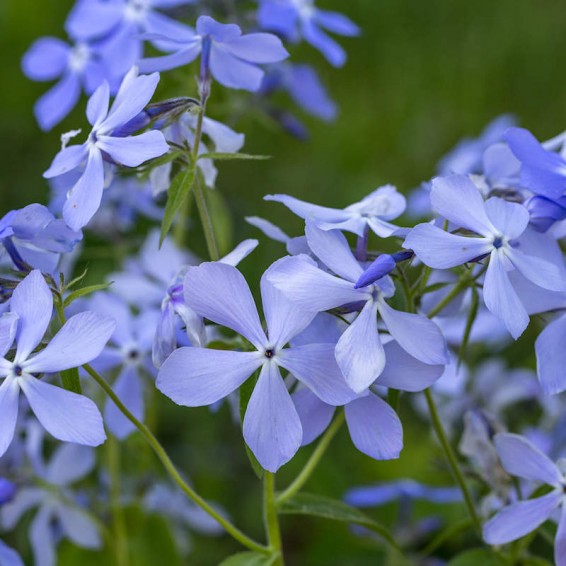Wild Blue Phlox Seeds
- HOW TO GROW
- FAST FACTS
- REVIEWS
HOW TO GROW
Sowing: Direct sow in late fall, planting just below the surface of the soil. For spring planting, mix the seeds with moist sand and store in the refrigerator for 60 days before planting. Keep the soil lightly moist until germination. This seed can also be started indoors 6-8 weeks before planting in the spring; the best temperature for germination is 65 degrees F.
Growing: Water seedlings until they become established. Mature plants tolerate occasional drought, though they prefer moist soil and will benefit from watering in dry weather. Deadhead for increased blooming. If seeds are not required, cut the plant back after blooming has finished. This plant often spreads, and is highly attractive to bees, hummingbirds, and butterflies. This plant makes an excellent ground cover, border plant, or addition to a rock garden.
Harvesting: For cut flowers, choose stems with flowers that have just opened. Strip the foliage that will fall below the water level, and place in water immediately.
Seed Saving: After the flowers fade, small pods will form that eventually open and release their seeds. Gather the pods as soon as they have begun to turn brown, but before they burst open; watch them carefully to prevent loss, since the seeds can easily be blown away by the wind. Spread the pods out to dry. As soon as they have completely dried, break open the pods and remove the seed. Store the seed in a cool, dry place.
FAST FACTS
Common Names: Blue Woodland Phlox
Latin Name: Phlox divaricata
Species Origin: US Native Wildflower
Type: Native Wildflowers
Life Cycle: Perennial
USDA Zones: 3, 4, 5, 6, 7, 8
US Regions: Midwest, Northern, Northeast, Southeast
Seeds per Ounce: 12,300
Stratification: Cold/Wet for 8 Weeks
Germination Ease: Stratify 8 Weeks
Sunlight: Part Sun, Shade
Height: 12 Inches
Color: Blue
Bloom Season: Blooms Early Spring, Blooms Late Spring
Uses: Attracts Pollinators, Hummingbirds, Aromatic, Cut Flowers, Deer Resistant
Phlox seeds
I search several nursery websites looking for phlox seeds. Everwilde Farms put me on a wait list and notified me when they were available. Much appreciated.
Looks great!
So excited to find these seeds! Shipped well and neatly and can't wait to get going!
I LOVE WILD PHLOX!
I grew up with these growing wild on a hill on a farm next to the road. I would pick a bouquet for my mother for Mother's Day—that's about when they bloomed in KY back then. I'm in a different state now, and when I saw these, I was excited to get them for home. I haven't planted them yet because I think they'd do better planted around the first of May.
Great selection filters for native plants
I have been trying to grow native plants for the environmental benefits and to support insect and bird populations. You're website made it so easy to identify native flowers for my region. The growing tips are also much appreciated.
Phlox arrived!
Just got my phlox seeds. They came quickly, were well packaged, good instructions. Now I just have to wait to plant them!
So far so good
Have not planted seeds yet. However, they came promptly and in a durable foil packet with planting instructions and care. So far so good. Very pleased so far.
DESCRIPTION

HOW TO GROW
Sowing: Direct sow in late fall, planting just below the surface of the soil. For spring planting, mix the seeds with moist sand and store in the refrigerator for 60 days before planting. Keep the soil lightly moist until germination. This seed can also be started indoors 6-8 weeks before planting in the spring; the best temperature for germination is 65 degrees F.
Growing: Water seedlings until they become established. Mature plants tolerate occasional drought, though they prefer moist soil and will benefit from watering in dry weather. Deadhead for increased blooming. If seeds are not required, cut the plant back after blooming has finished. This plant often spreads, and is highly attractive to bees, hummingbirds, and butterflies. This plant makes an excellent ground cover, border plant, or addition to a rock garden.
Harvesting: For cut flowers, choose stems with flowers that have just opened. Strip the foliage that will fall below the water level, and place in water immediately.
Seed Saving: After the flowers fade, small pods will form that eventually open and release their seeds. Gather the pods as soon as they have begun to turn brown, but before they burst open; watch them carefully to prevent loss, since the seeds can easily be blown away by the wind. Spread the pods out to dry. As soon as they have completely dried, break open the pods and remove the seed. Store the seed in a cool, dry place.
FAST FACTS
Common Names: Blue Woodland Phlox
Latin Name: Phlox divaricata
Species Origin: US Native Wildflower
Type: Native Wildflowers
Life Cycle: Perennial
USDA Zones: 3, 4, 5, 6, 7, 8
US Regions: Midwest, Northern, Northeast, Southeast
Seeds per Ounce: 12,300
Stratification: Cold/Wet for 8 Weeks
Germination Ease: Stratify 8 Weeks
Sunlight: Part Sun, Shade
Height: 12 Inches
Color: Blue
Bloom Season: Blooms Early Spring, Blooms Late Spring
Uses: Attracts Pollinators, Hummingbirds, Aromatic, Cut Flowers, Deer Resistant
Reviews
Review
Phlox seeds
I search several nursery websites looking for phlox seeds. Everwilde Farms put me on a wait list and notified me when they were available. Much appreciated.
Review
Looks great!
So excited to find these seeds! Shipped well and neatly and can't wait to get going!
Review
I LOVE WILD PHLOX!
I grew up with these growing wild on a hill on a farm next to the road. I would pick a bouquet for my mother for Mother's Day—that's about when they bloomed in KY back then. I'm in a different state now, and when I saw these, I was excited to get them for home. I haven't planted them yet because I think they'd do better planted around the first of May.
Review
Great selection filters for native plants
I have been trying to grow native plants for the environmental benefits and to support insect and bird populations. You're website made it so easy to identify native flowers for my region. The growing tips are also much appreciated.
Review
Phlox arrived!
Just got my phlox seeds. They came quickly, were well packaged, good instructions. Now I just have to wait to plant them!
Review
So far so good
Have not planted seeds yet. However, they came promptly and in a durable foil packet with planting instructions and care. So far so good. Very pleased so far.





